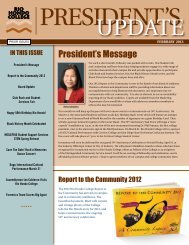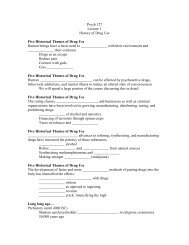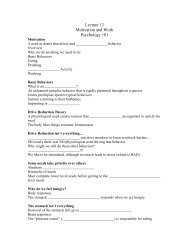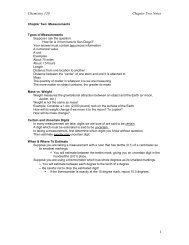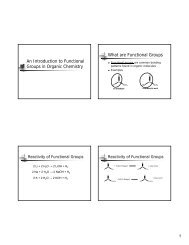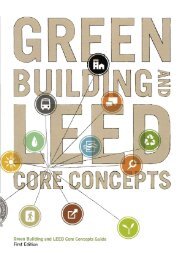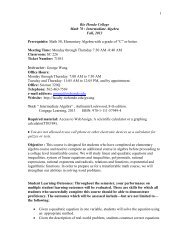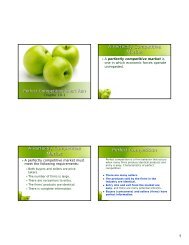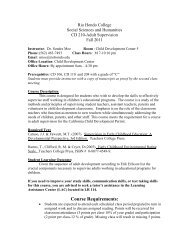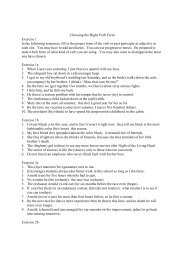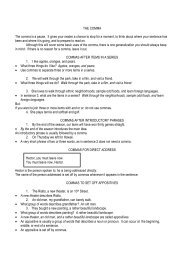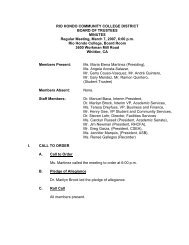Complete College Catalog 2011-2012 - Rio Hondo College
Complete College Catalog 2011-2012 - Rio Hondo College
Complete College Catalog 2011-2012 - Rio Hondo College
You also want an ePaper? Increase the reach of your titles
YUMPU automatically turns print PDFs into web optimized ePapers that Google loves.
competitive sports activities. Coaching<br />
methodologies and future trends<br />
in athletics, physical activities, and<br />
physical education will be discussed. An<br />
emphasis will be placed on developing<br />
an appreciation for sports, athletics, and<br />
physical education. Upon the successful<br />
completion of this course, students will<br />
have satisfied the (Title V) requirements<br />
for the State of California that allows<br />
them to high school sports teams.<br />
3 Units<br />
54 Lecture hours<br />
PETH 196<br />
Health: Fitness and Wellness<br />
Advisory: ENGL 035 or ESL 198 or<br />
appropriate assessment; READ 023 or<br />
appropriate assessment<br />
Transfers to: UC (credit limit*), CSU<br />
(*Students will receive credit from UC<br />
for only one of the following courses:<br />
PETH 191, PETH 192, or PETH 196)<br />
This course is designed for all students<br />
who are interested in learning the<br />
value of life-long, healthy lifestyles.<br />
Students will be given the tools to<br />
assist them in making positive lifestyle<br />
changes based on a personal<br />
health/fitness profile. Topics<br />
covered include: basic anatomy and<br />
physiology, nutrition, weight control,<br />
tobacco and alcohol, muscle fitness,<br />
flexibility, stress reduction, and<br />
cardiovascular functioning.<br />
3 Units<br />
54 Lecture hours<br />
PETH 197<br />
Prevention and Treatment of Athletic<br />
Injuries<br />
Advisory: ENGL 035 or ESL 198 or<br />
appropriate assessment; READ 023 or<br />
appropriate assessment<br />
Transfers to: UC, CSU<br />
This course introduces the basic<br />
concepts of athletic training, including<br />
instruction for prevention, recognition,<br />
management and treatment of common<br />
injuries in a physically active population.<br />
The skills of basic strapping, bracing<br />
padding and taping for the prevention<br />
and support of injuries will be<br />
presented and practiced. This class is<br />
recommended for those interested in<br />
becoming a Certified Athletic Trainer.<br />
3 Units<br />
54 Lecture hours<br />
PETH 198<br />
Contemporary Issues Related to<br />
Athletic Participation<br />
Advisory: ENGL 030 or ESL 197 or<br />
appropriate assessment; READ 022 or<br />
appropriate assessment<br />
Transfers to: CSU<br />
This course is designed for students<br />
who are interested in athletic<br />
competition. This course presents an<br />
overview of contemporary societal<br />
issues that have a significant impact on<br />
the ability of athletes to be successful<br />
in a competitive environment. Topics<br />
to be covered in this course include<br />
decision making skills, substance<br />
abuse, sexual behavior, eating<br />
disorders, and athletic eligibility<br />
requirements.<br />
1 Unit<br />
18 Lecture hours<br />
PETH 297<br />
Advanced Athletic Training<br />
Prerequisite: PETH 197<br />
Advisory: ENGL 035 or ESL 198 or<br />
appropriate assessment; READ 023 or<br />
appropriate assessment<br />
Transfers to: CSU<br />
This course introduces the advanced<br />
concepts of athletic training, including<br />
instruction for evaluation and<br />
rehabilitation of common athletic<br />
injuries. Advanced taping and bracing<br />
techniques will also be presented and<br />
practiced. This class is designed for<br />
students interested in becoming a<br />
Certified Athletic Trainer or those who<br />
are preparing for a career in any allied<br />
health care profession.<br />
3 Units<br />
54 Lecture hours<br />
____________________<br />
PHYSICAL SCIENCE<br />
Division of Mathematics & Sciences<br />
PHYS 101<br />
Physics and Chemistry for Teachers<br />
Advisory: ENGL 035 or ESL 198 or<br />
appropriate assessment; READ 023 or<br />
appropriate assessment; MATH 050 or<br />
appropriate assessment<br />
Transfers to: CSU<br />
Designed for the future elementary<br />
school teacher, this laboratory science<br />
course introduces students to the<br />
fundamentals of physics and chemistry<br />
including properties of the states of<br />
matter, physical and chemical changes,<br />
solutions and mixtures, motion, forces,<br />
energy and light.<br />
4 Units<br />
54 Lecture hours<br />
54 Lab hours<br />
PHYS 102<br />
Earth and Space Sciences for Teachers<br />
Advisory: ENGL 035 or ESL 198 or<br />
appropriate assessment; READ 023 or<br />
appropriate assessment; MATH 050 or<br />
appropriate assessment<br />
Transfers to: CSU<br />
Designed for the future elementary<br />
school teacher, this laboratory science<br />
course introduces students to the<br />
fundamentals of earth and space<br />
sciences including the universe,<br />
the solar system, the structure and<br />
composition of the Earth, the Earth’s<br />
atmosphere, and the Earth’s water.<br />
4 Units<br />
54 Lecture hours<br />
54 Lab hours<br />
____________________<br />
PHYSICS<br />
Division of Mathematics & Sciences<br />
PHY 120<br />
Physics for Everyday Use<br />
Prerequisite: MATH 050 with a grade of<br />
“C” or better or appropriate assessment<br />
Advisory: ENGL 035 or ESL 198 or<br />
appropriate assessment; READ 023 or<br />
appropriate assessment<br />
Transfers to: UC (credit limit*), CSU<br />
(*Students will receive no credit from<br />
UC for PHY 120 if taken after PHY 150<br />
or PHY 211)<br />
This course investigates the basic<br />
characteristics of matter and the<br />
interactions that govern its behavior<br />
and emphasizes how remarkable<br />
everyday phenomena are. Examples<br />
from popular culture (movies, TV,<br />
and sports) are emphasized. Topics<br />
include how to describe an object’s<br />
motion, how to explain changes in an<br />
object’s motion, the roles of work and<br />
energy, and other topics. The course<br />
is oriented to the non-science major,<br />
stresses conceptual understanding,<br />
and is intended to present students<br />
with an opportunity to see how our<br />
world works.<br />
4 Units<br />
54 Lecture hours<br />
54 Lab hours<br />
PHY 150<br />
General Physics - I<br />
Prerequisite: MATH 175 with a grade of<br />
“C” or better or appropriate assessment<br />
Advisory: ENGL 035 or ESL 198 or<br />
appropriate assessment; READ 023 or<br />
appropriate assessment<br />
Transfers to: UC (credit limit *), CSU<br />
(*Students will receive credit from UC<br />
for one physics series: PHY 150 and<br />
PHY 160 or PHY 211, PHY 212, and<br />
PHY 213)<br />
This course is the first of a twosemester<br />
sequence and is designed<br />
for students transferring to a fouryear<br />
institution and planning careers<br />
in health professional fields such<br />
as medicine, dentistry, veterinary<br />
science, pharmacy, and optometry as<br />
well as those students in engineering<br />
technology and architecture. Students<br />
majoring in the biological sciences<br />
should consult a counselor as to<br />
whether this course satisfies the<br />
general preparation requirements for<br />
the major at the university. Topics<br />
include kinematics, dynamics, energy,<br />
work, momentum, and conservation<br />
principles.<br />
4 Units<br />
54 Lecture hours<br />
54 Lab hours<br />
PHY 160<br />
General Physics - II<br />
Prerequisite: PHY 150 with a grade of<br />
“C” or better<br />
Transfers to: UC (credit limit *), CSU<br />
(*Students will receive credit from UC<br />
for one physics series: PHY 150 and<br />
PHY 160 or PHY 211, PHY 212, and<br />
PHY 213)<br />
This course is the second of a twosemester<br />
sequence and is designed<br />
for students transferring to a<br />
four-year institution with majors<br />
in health professional fields such<br />
as medicine, dentistry, veterinary<br />
science, pharmacy, and optometry as<br />
well as those students in engineering<br />
technology and architecture. Students<br />
majoring in the biological sciences<br />
should consult a counselor as to<br />
whether this course satisfies the<br />
general preparation requirements for<br />
<strong>2011</strong>-<strong>2012</strong> <strong>Catalog</strong> <strong>Rio</strong> <strong>Hondo</strong> <strong>College</strong> / 231



